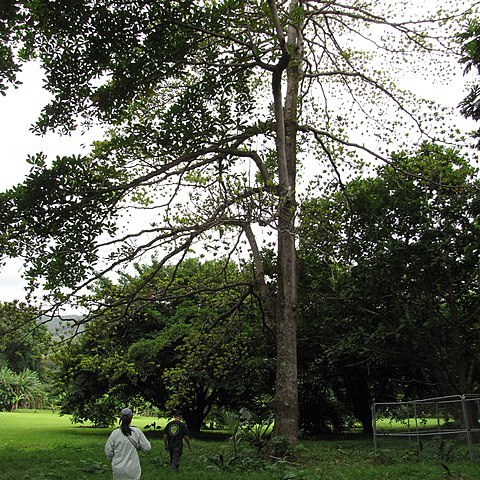Buttressed tree, 35-45 m, with a large, spreading crown. Outer bark grey or grey-brown; inner purple or mauve, then brown against the cambium. Sapwood poorly defined, light with concentric wavy rings, sometimes almost porous. Young branchlets fulvous-tomentose, stout or very stout. Leaves coriaceous, spirally arranged along the branchlets, sometimes rather crowded in whorls towards the tips, finely reticulate above, somewhat shiny, remaining tomentose on the midrib and principal nerves, obscurely minutely verruculose, fulvous or rufous-tomentose below especially on the nerves, finally becoming nearly glabrous, rather obscurely pellucid-punctate at some stages of development, obovate-ellptic, narrowly obovate-ellptic or obovate-oblong, 12-35 by 5-12 cm, rounded and sometimes shortly acuminate or mucronate at the apex, cuneate or occasionally rounded at the base sometimes with 2 conspicuous black glands; nerves 10-18 pairs, domatia absent or inconspicuous; petiole fulvous-or rufous-tomentose or tomentellous, 1-2 cm, occasionally with 2 glands at or near the middle. Flowers sessile, rather large for the genus, in axillary spikes 10-12 cm long; rhachis fulvous-or rufous-tomentose. Bracts hairy, caducous, 1 mm long. Lower receptacle (ovary) fulvous-tomentellous, 5 mm long; upper receptacle shallow-cupuliform, fulvous-tomentellous, 2-2½ by 6-7 mm. Calyx-lobes fulvous-tomentellous, broadly ovate-deltoid, 2½ by 2½-3 mm. Filaments glabrous, 6-12 mm; anthers 0.8 mm long. Disk densely pilose. Style glabrous, 5-8 mm. Fruit red, fleshy, at first tomentose, nearly glabrous when ripe, ellpsoid, more or less laterally compressed, 6-17½ by 4-8 by 3½-6 cm, slightly beaked at the apex, the endocarp showing in cross-section a broad band of very hard sclerenchymatous tissue including in it some irregularly shaped and irregularly spaced air-chambers and a rather large loculus (up to 2½ by 2 cm in larger fruits) containing the edible kernel.
More
A large tree. It can be 20-30 m tall. It usually has buttresses. The branches are in layers and the leaves are mostly near the ends of the thick twigs. The twigs are hairy when young. The young leaves are yellow-green. The leaves are large, hairy and reddish brown. The leaf stalks are 2 cm long. The leaves can be 15-28 cm long by 6-13 cm wide. They are thick and with a tip at the end. They taper towards the base. The veins often stick out underneath the leaf and are depressed on the upper surface of the leaf. The flowers occur on spikes which stick upwards. The buds are usually hairy. The flower stalks are shorter then T. impediens. The fruit is very large, up to 11 cm x 8 cm and slightly flattened. They are red and smooth when ripe. The fruit have reddish brown hairs when young. The fruit has a large woody stone inside. The stone inside the fruit splits into 2 more or less equal parts. The seedling leaves are 3-4 and thin.
Uses. The wood is medium hard inclined to be brittle. The fruit, which is by far the largest known in the Combretaceae, is edible, the kernel being one of the best-flavoured tropical nuts and a favourite article of diet among the natives.
More
The kernel inside the stone of the fruit is edible. It is eaten raw and also roasted or baked. The seed can be pressed to extract oil.


